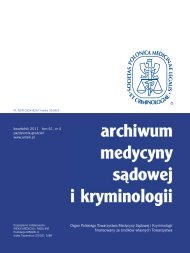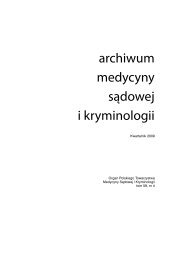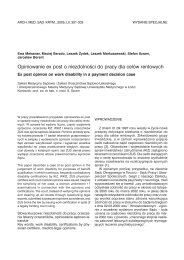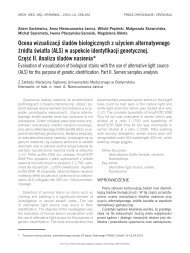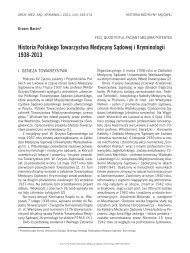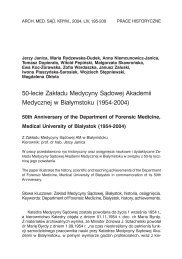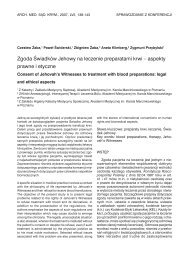Population Studies for STR Loci (D3S1358 ... - ResearchGate
Population Studies for STR Loci (D3S1358 ... - ResearchGate
Population Studies for STR Loci (D3S1358 ... - ResearchGate
You also want an ePaper? Increase the reach of your titles
YUMPU automatically turns print PDFs into web optimized ePapers that Google loves.
216 M. Saqib ShahzadNr 4Keywords / słowa kluczowe:Forensic biology, <strong>STR</strong> loci, Allelic frequency, NWFP (North West FrontierProvince) and Sindhi population.Abbreviations / skróty:North West Frontier Province (NWFP)Centre of Excellence in Molecular Biology (CEMB)FGA (FIBRA)Short Tandem Repeat (<strong>STR</strong>)Polyacrylamide Gel Electrophoresis (PAGE)DeoxyRiboNucleic Acid (DNA)Amplified Fragment Length Polymorphism (AmpFLP)Variable Number of Tandem Repeats (VNTR)Combined DNA Index System (CODIS)Tris EDTA (TE)Polymerase Chain Reaction (PCR)INTRODUCTIONThe genetic uniqueness of individuals is a central tenet of human biology.This uniqueness is defined by the combination of genetic markers that anindividual inherits from his or her parents. Genetic markers can be analyzedeither at the level of protein or DNA variation. DNA technology makes possiblethe study of human variability at the most basic level, the level of geneticmaterial, DNA (Deoxy Ribonucleic Acid) [17]. Traditionally, the term DNAfingerprinting refers to the patterns, which are highly characteristic <strong>for</strong> anyhuman individual, of the ridged skin of the distal finger phalanges. The geneticcomplexity of DNA fingerprints is enormous [11].Previous methods using blood groups and proteins have analyzed geneproducts, rather than DNA itself. In addition to providing more direct geneticin<strong>for</strong>mation, DNA can withstand environmental conditions that destroy proteins,so old, badly degraded samples of body fluids still can provide abundantin<strong>for</strong>mation as DNA typing has been done of a human body exhumed after 27years [20].The advent of DNA typing in the mid-1980s has had an enormous effect onthe ability of crime laboratories to identify individuals uniquely by testing avariety of their body fluids. In the past 15 years, technologies <strong>for</strong> individualidentification have moved at a breathtaking pace. The first <strong>for</strong>ensic samples tobe typed by DNA procedures required at least 25–100 times more sampledDNA than is currently needed <strong>for</strong> a result. The incorporation of modernmolecular biological techniques in the crime laboratory has resulted, at aremarkably increasing rate, in the identification of criminals and the exonerationof the innocent. The advent of modern DNA technology has resulted in the
Nr 4 BADANIA POPULACYJNE LOCI <strong>STR</strong>217increased ability to per<strong>for</strong>m human identity. Individual identification is desirablein a number of situations including the determination of perpetrators of violentcrime such as murder and rape, resolving unestablished paternity, andidentifying remains of missing persons or victims of mass disasters.The tandemly repeated sequence of 3 to 7 bp is core sequence of <strong>STR</strong>DNA. These abundant repeats are well distributed throughout the humangenome and are rich sources of highly polymorphic markers, which oftenmay be detected using PCR [18]. Polymorphic <strong>STR</strong> markers are those, whichare varying in the length of core repetitive sequence of nucleotides. <strong>STR</strong> typingis more tolerant to the use of degraded DNA templates than other methods ofindividual identification because the amplification products are less than 400bplong, much smaller then the material detected with AmpFLP (Amplified fragmentLength Polymorphism) [6] or VNTR (Variable Number of Tandem Repeats)[14] analysis. The <strong>STR</strong> markers were selected according to their highdiscrimination power (>0.9) and high heterozygosity (>80%) already reported<strong>for</strong> different population of the world [7]. Thirteen <strong>STR</strong> loci were selected <strong>for</strong>use in the combined DNA index system shortly called CODIS [4], which is<strong>STR</strong> database of genotype of selected <strong>STR</strong>s.If a probability calculation on the basis of the population data is neededthen the <strong>for</strong>ensic DNA scientist must know genotype of that specific localpopulation <strong>for</strong> selected <strong>STR</strong> marker [1]. This indicates the necessity ofpreparation and maintenance of records of genotypes of a specific <strong>STR</strong> markeror database of selected <strong>STR</strong> marker <strong>for</strong> the local population. All those countriesof the world that are exploiting <strong>STR</strong> DNA <strong>for</strong> crime investigation have establisheddatabases.Results of the present study will not only help the DNA analyst to generatethe DNA profile <strong>for</strong> five <strong>STR</strong> loci but also give facts and figures about allelicfrequency, genotypic frequency and heterozygosity of the selected <strong>STR</strong>markers <strong>for</strong> the Pakistani population. The finding of this study will be useful toundertake statistical analysis in order to prove the matching of the DNA profilebetween crime scene sample and the suspect to be unique in our population.MATERIALS AND METHODSBlood samples were collected from 209 unrelated in<strong>for</strong>med volunteers fromNWFP (North West Frontier Province) and Sindh provinces. From each individual,3ml of blood was drawn. Phenol chloro<strong>for</strong>m DNA extraction [19] was per<strong>for</strong>medon each of the blood samples. The quantity of the extracted DNA in the TE (TrisEDTA) solution was estimated initially by Spectrophotometery followed by YieldGel Electrophoresis.PCR (Polymerase Chain Reaction) conditions <strong>for</strong> all five <strong>STR</strong> loci (<strong>D3S1358</strong>,D5S818, D7S820, D18S51 and FGA) were optimized using MJ Research Inc.PTC-100 and Hybaid Thermal Cycler and then PCR <strong>for</strong> all these loci was run
218 M. Saqib ShahzadNr 4<strong>for</strong> all the collected samples. PCR products were checked on 2% maxi agarosegel. Denaturing Polyacrylamide Gel Electrophoresis (PAGE) was run to checkthe genotypic ratios and allelic frequencies of the populations of both theprovinces <strong>for</strong> five <strong>STR</strong> markers. The data were statistically analyzed using theChi Square test.RESULTSThe genotypic data of NWFP (North West Frontier Province) and Sindhipopulations was statistically analyzed. This statistical analysis included;observed allelic frequencies, observed and expected genotypic ratios andobserved and expected heterozygosities. The Hardy Weinberg Equilibriumwas tested <strong>for</strong> this data by the chi square test. Table I shows the allelicfrequencies of loci <strong>D3S1358</strong>, D5S818, D7S820, D18S51 and FGA.DISCUSSIONSThe establishment of a reference genotypic database of Sindhi and NWFP(North West Frontier Province) populations and obtained statistical findingsare presented <strong>for</strong> these populations in order to use <strong>for</strong> probability calculationsduring crime investigation and in <strong>for</strong>ensic casework. The Pakistani populationis ethnically diverse and consists of four provinces and many sub groups.<strong>Population</strong> data <strong>for</strong> <strong>STR</strong> loci has been reported by a number of scientistsaround the world [3, 9, 10, 13, 16]. NWFP and Sindhi population have beenscreened on non-ethnic basis. The DNA was extracted from whole bloodsamples using an organic extraction method. The DNA extraction by PhenolChloro<strong>for</strong>m method gives good yield [19] and is suitable <strong>for</strong> PCR based DNAtyping technique [8].Each sample was amplified <strong>for</strong> the five <strong>STR</strong> loci and resolved on 8%denaturing PolyAcrylamide gel followed by silver staining. Bassam et al. [2],Budowle and Allen [5] has used denaturing polyacrylamide gel and foundthis technique useful <strong>for</strong> the resolution of <strong>STR</strong> loci. Amplicons of the developedmultiplex were pooled and reprecipitated. Different alleles at each locus weredetermined using 50bp DNA ladder marker. At each locus most of the reportedalleles were found in sampled population.Allele frequencies of locus <strong>D3S1358</strong>, D5S818, D7S820, D18S51 and FGAranged from 0.1650-0.0071, 0.0574-0.1578, 0.1100-0.0550, 0.0669-0.0789,0.0239-0.0119 <strong>for</strong> alleles 13-17.1, 8-12, 5-11, 9.1-19.3 and 16-25 respectively(See Tab. I <strong>for</strong> all the allele frequencies).
220 M. Saqib ShahzadNr 4Nazneen et al. [15] have reported the allele frequencies <strong>for</strong> loci vWA,<strong>D3S1358</strong> and D16S539 in the Lahori population at random. According to theirfindings, the allele frequencies <strong>for</strong> locus <strong>D3S1358</strong> ranged from 0.050 <strong>for</strong> allelenumber 13 to 0.080 <strong>for</strong> allele number 17. Their data varied from our findingswhich were <strong>for</strong> the NWFP (North West Frontier Province) and Sindhi populationsof Pakistan, where frequencies ranged from 0.1650-0.0071 <strong>for</strong> alleles 13-17.There is no published data <strong>for</strong> all the other five loci. Shaista Khanum hasreported [12] the allele frequencies <strong>for</strong> the locus D18S51 in Punjabi populationof Pakistan in her thesis, which ranged from 0.0142-0.0020 <strong>for</strong> alleles 9.2-25.This also varied from our data, which showed a range from 0.0669-0.0789 <strong>for</strong>alleles numbered 9.1-19.3. This comparison indicates that the overall Pakistanipopulation is diverse and allele frequencies vary from place to place.The Chi square test was applied to check the population <strong>for</strong> Hardy WeinbergEquilibrium. Chi Square values are 0.5754 <strong>for</strong> <strong>D3S1358</strong>, 3.5402 <strong>for</strong> D5S818,1.4840 <strong>for</strong> D7S820, 0.8937 <strong>for</strong> D18S51 and 0.04834 <strong>for</strong> FGA indicating thatthe results are non significant and obey the Hardy Weinberg Equilibrium sothese five <strong>STR</strong> makers alone are not sufficient enough to generate a database.The discrimination power of these <strong>STR</strong> markers is insufficient but the highheterozygosity values [Tab. II] suggest that in combination with further markers,these <strong>STR</strong> markers can be used to generate a database with full confidenceand accuracy.Table II Heterozygosity at three <strong>STR</strong> loci (D5S818, D7S820 AND D18S51) in PakistanipopulationTab. II. Heterozygotyczność w zakresie trzech badanych loci <strong>STR</strong>Locus Expected Observed Chi squareOczekiwana Obserwowana<strong>D3S1358</strong> 79.3663 86.124 0.5754D5S818 80.2717 97.1292 3.5402D7S820 84.046 95.215 1.4840D18S51 90.0712 99.0431 0.8937FGA 89.3192 91.388 0.04834These values are non-significant which indicate that our population obeys theHardy – Weinberg equilibrium.
Nr 4 BADANIA POPULACYJNE LOCI <strong>STR</strong>221REFERENCES1.Balding D.J., Nichols R.A. DNA match probability calculation: how to allow<strong>for</strong> population stratification, relatedness, database selection and single bands.Forensic Sci. Int. 1994, 64, 125-140. – 2. Bassam B. J., Caetano-Anolles G.,Gresshoff P. M. Fast and sensitive silver staining of DNA in polyacrylamidegels. Anal. Biochem. 1991, 196, 80. – 3. Bever R.A., Creacy S. Validation andcommercialization of available <strong>STR</strong> multiplexes <strong>for</strong> parentage analysis.Proceedings <strong>for</strong> the 5 th International Symposium on Human Identification, 1995,Pp.61-63. – 4. Budowle B. Examples of <strong>STR</strong> population database <strong>for</strong> CODISand <strong>for</strong> case work Presented at the 9 th Symposium on Human Identification.Orlando, FL, 1998. – 5. Budowle B., Allen R. C. Discontinuous polyacrylamidegel electrophoresis of DNA fragments. In: Mathew C. (ed.). Methods inMolecular Biology– Molecular Biology in Medicine. Vol. 7. Humana, London,1990. – 6. Budowle B., Baechtel F. S., Comey C., Guisti A., Klevan L. Simpleprotocols <strong>for</strong> Typing Forensic Biological Evidence: Chemiluminescent Detection<strong>for</strong> Human DNA Quantitation and Restriction Fragment Length Polymorphism(RELP) Analysis and Manual Typing of polymerase chain reaction (PCR)Amplified polymorphisms. Electrophoresis 1995, 16, 1559-1567. – 7. BudowleB., Moretti T. R., Baumstark A. L., Defenbaugh D. A., Keys K. M. <strong>Population</strong>data on the thirteen CODIS core short tandem repeat loci in African Americans,U.S. Caucasians, Hispanics, Bahamians, Jamaicans, and Trinidadians. J.Forensic Sci. 1999, 44 (6), 1277-1286. – 8. de Pancorbo M. M., Castro A.,Fernandez I., Garcia – Orad A. <strong>Population</strong> genetics and <strong>for</strong>ensic applicationusing multiplex PCR (CSFIPO, TPOX, and TH01) loci in the Basque Country.J. Forensic Sci. 1998, 43, 1181-1187. – 9. Edwards A., Hammond H.A.,Chakraborty R. Genetic variation at five trimeric and tetra meric random repeatsloci in four human population groups. Genomics 1992, 12, 241-253. – 10.Hammond H. A., Jin L., Zhong Y., Caskey C. T., Chakraborty R. Evaluation of13 short Tandem Repeat loci <strong>for</strong> use in personal Identification Applications.Am. J. Hum. Genet. 1994, 55, 175-189.11. Jefferys A. J., Wilson V., Thein L. S., Weaterall D. J., Ponder, B. A. J. ForensicDNA data banking by state crime laboratories. Am. J. Hum. Genet. 1986, 39,11. – 12. Khanum S. Allelic frequency distribution of <strong>STR</strong> loci (D8S1179, D18S51and D21S11) in punjabi population of Pakistan. Thesis, National Centre ofExcellence in Molecular Biology, University of the Punjab, Lahore, Pakistan,2002. – 13. Lins A.M., Sprecher C.J., Puers C., Schumm J.W. Multiplex sets <strong>for</strong>the amplification of polymorphic <strong>STR</strong> loci, silver stain and fluorescent detection.Biotechniques 1996, 20, 882-889. – 14. Nakamura Y., Leppert M., O’Connel P.,Wolfe R., Holm T., Culver M., Martin C., Fujimoto E., Hoff M., Kumlin E., WhiteR. Variable number of tandem repeat (VNTR) markers <strong>for</strong> human gene mapping.Science 1987, 235, 1616-1622. – 15. Nazneen A., Rahman Z., Riazuddin S.Allelic and genotypic frequency distribution at three <strong>STR</strong> loci (vWA, <strong>D3S1358</strong>and D16S539) in Pakistani population. Int. J. Agricult. Biol. 2002, 1560-8530 /
222 M. Saqib ShahzadNr 404-1-8-11. – 16. Puers C., Hammond H. A., Jin L., Caskey C. T., Schumm J. W.Identification of repeat sequences heterogeneity at the polymorphic shorttandem repeat locus HUMTH01 [AATG]n and reassignment of alleles inpopulation analysis by using a locus-specific allelic ladder. Am. J. Hum. Genet.1993, 53, 953-958. – 17. Rebecca R., Sensabaugh G. Analysis of GeneticMarkers in Forensic DNA samples using the Polymerase Chain Reaction.Reprinted from Analytical Chemistry 1991, 63. – 18. Sambrook J., Fritsch E.F.,Maniatis T. Chapter 14: In vitro amplification of DNA by the polymerase chainreaction. In: Molecular cloning: A laboratory Manual, Second edition, ColdSpring Harbor Laboratory Press, Cold Spring Harbor, New York, 1989. – 19.Signer E., Kuenzle C. C., Thomann P. E., Hubscher U. DNA fingerprinting:Improved DNA extraction from small blood samples. Nucleic Acids Res. 1988,16, 7738. – 20. Tahir M.A., Balraj E., Luke L., Gilbert T., Hamby J.E., Amjad M.DNA typing of samples <strong>for</strong> polymarker, DQA1, and nine <strong>STR</strong> loci from a humanbody exhumed after 27 years, J. Forensic Sci. 2000, 45 (4), 902-907.Corresponding Author / Adres pierwszego autora:M. Saqib ShahzadHouse No. C/114Ward No 12Muzaffar Garh, PunjabPakistan 34200E-mail: saqib1330@yahoo.com.



